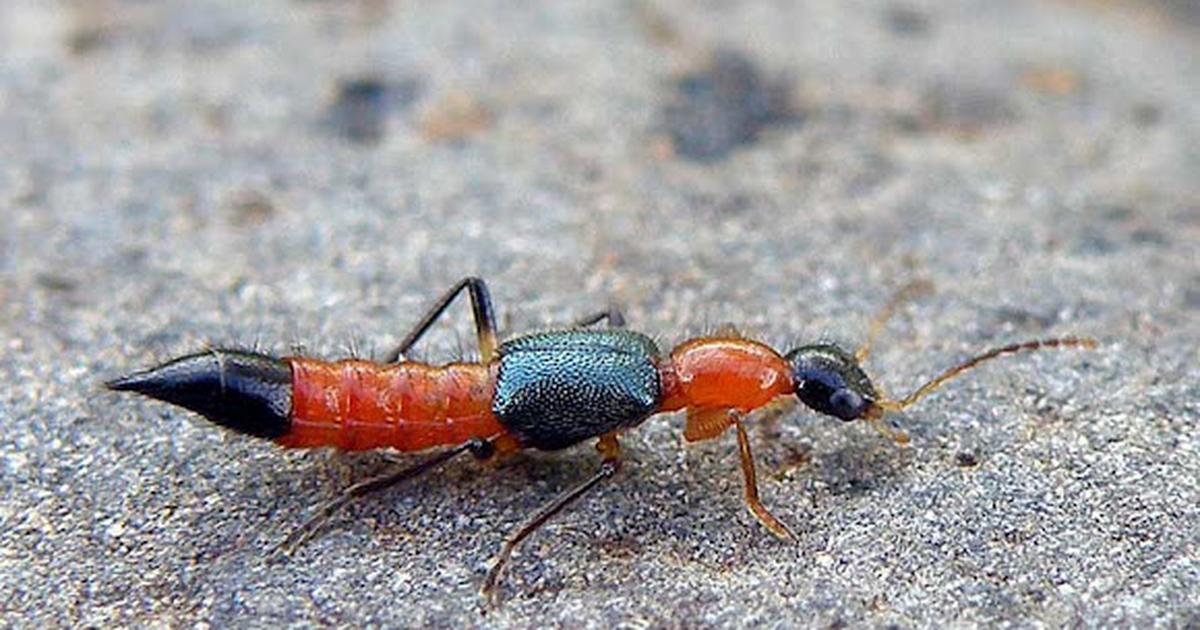The Nairobi fly, scientifically known as Paederus fuscipes, is a small but striking insect that is commonly found in tropical regions, especially in Kenya. Despite its name, the Nairobi fly is not actually a true fly. It belongs to the family Staphylinidae, which is a group of beetles known as rove beetles. The Nairobi fly is notable for both its distinctive appearance and the potential health risks it poses due to its toxic secretions.
Appearance
The Nairobi fly is a relatively small insect, with adults measuring approximately 7-10 mm in length. It has a long, slender body that is primarily black in color, with striking red or orange markings on its thorax (the middle section of its body). These vibrant colors serve as a warning to predators, signaling that the insect may be toxic or unpleasant to consume.
Its elongated body features two prominent wings, although it is often seen in flight or crawling on surfaces. The head is small compared to the rest of the body, and the insect has large, compound eyes typical of many beetles. Nairobi flies also have six legs, which they use for walking, although they are not particularly fast movers.
The striking red or orange markings are one of the insect's most identifiable features. However, these markings are not simply for aesthetic purposes; they are a warning sign, indicating that the insect can release a toxic substance when threatened.
Behaviour
Nairobi flies are primarily active during the warmer months, particularly in the rainy season, when they are more abundant. They tend to live in areas with plenty of organic matter, including fields, gardens, and forests. These insects are often found crawling on vegetation, where they feed on smaller insects, such as aphids. They are predatory in nature, and their role in the ecosystem helps control pest populations.
Feeding Habits
The Nairobi fly is not a pest in the conventional sense. Rather than feeding on crops or plants directly, it feeds on other insects. Its diet consists mainly of smaller invertebrates, which it captures using its predatory instincts. Although they are not known to damage crops directly, their presence can still be an inconvenience to humans.
Reproductive Behaviour
The reproductive behaviour of Nairobi flies is typical of many rove beetles. Females lay their eggs in moist, organic environments, such as decomposing leaves or soil. The larvae that hatch from these eggs are carnivorous and will feed on smaller insects. As the larvae grow, they go through several stages of development before reaching adulthood.
Toxic Secretion and Human Interaction
Perhaps the most notorious aspect of the Nairobi fly is its ability to produce a toxic secretion. This secretion, which is produced by specialized glands in the insect's body, contains chemicals known as paederin. When threatened or disturbed, the Nairobi fly can secrete this toxin onto its body surface or into the air. If the substance comes into contact with human skin, it can cause a range of reactions, most notably skin irritation and blistering.
When humans are affected by this secretion, the symptoms usually include itching, redness, swelling, and sometimes the formation of blisters. In severe cases, the toxin can cause more serious reactions, including burns or eye damage if the toxin comes into contact with sensitive areas like the eyes.
It is important to note that the Nairobi fly does not bite or sting; rather, the danger comes from the toxin it releases when it feels threatened. The best way to avoid injury from a Nairobi fly is to handle the insect with caution, wearing gloves or using a tool to move it, and ensuring it does not come into contact with your skin.
Safety and Prevention
In areas where Nairobi flies are prevalent, such as parts of Kenya, it is important for people to take precautions. If you encounter one of these insects, avoid touching it with bare skin. Wearing long sleeves and pants can also reduce the chances of the fly making direct contact with your body.
If you do get exposed to the toxin, it is essential to wash the affected area with soap and water as soon as possible. Applying antiseptic cream can help alleviate irritation, and in more severe cases, seeking medical attention may be necessary.
The Nairobi fly, with its striking appearance and potential to cause harm through its toxic secretions, is a fascinating yet dangerous insect. While it plays an important ecological role by preying on smaller insects, its presence in residential or agricultural areas can pose risks to humans. Awareness of its behaviour and precautions to avoid direct contact are key to preventing harm when living or traveling in regions where Nairobi flies are common
More pest Control ServicesPestPro Facebook Page
Medium
